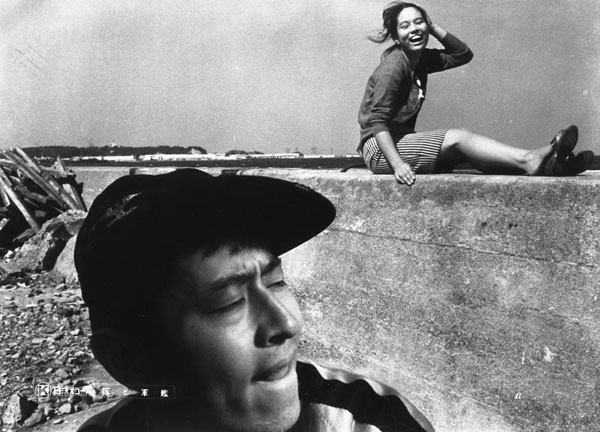With ongoing retrospectives in New York and London and a batch of what look to be extraordinary new releases on DVD and Blu-ray, I thought we’d dedicate a round exclusively to Japanese cinema. And we begin, of course, with Ozu, the Film Forum series running through June 27.
“Yes, Ozu favored a deliberate pace, and the performances might seem purposefully muted,” grants Time Out New York‘s David Fear, but: “you’ll also see characters talk about being horny, drink like fishes and ponder vulgar, scatological topics at length…. This was an artist who strove to show our species in all its melancholy, messy and magnificent modes, and whose rigorous formalism wasn’t meant to trap humanity in amber so much as give you a pristine room in which to contemplate life’s beauty and fucked-up-ness. He was an expert in cinematic depth charges: Underneath every meticulous image and pattern-recognition scenario is an emotional detonation designed to discreetly devastate you.” And Film Forum notes that David Bordwell‘s 2003 essay on Ozu for Artforum is available to non-subscribers. Bordwell also wrote the essay that accompanies Criterion’s release of Early Summer (1951).
“The retrospective of films by Shinsuke Ogawa and his collaborators screening at Anthology Film Archives from June 7 to June 18 provides a rare opportunity to see, mostly projected on film, a dozen or so examples of the work of this influential collective, producers of some of the most interesting ethnographic documentaries made anywhere in the world in the last part of the 20th century,” writes Jonathan Kahana in the Brooklyn Rail.
Seasons in the Sun: The Heyday of Nikkatsu Studios rolls on at BFI Southbank through the end of the month and, for Sight & Sound, Jasper Sharp tells the story of this “one-time home of such vibrant talents as Suzuki Seijun, Imamura Shôhei, Masuda Toshio and Kurahara Koreyoshi. In 1954, after a 12-year break in production, this sleeping giant of the pre-war era re-entered the film market refreshed and re-energised. Over the following decades, Nikkatsu’s burgeoning roster of unruly taiyôzoku (‘sun tribe’) youth movies, seductive star-driven dramas, flamboyant musicals and hard-boiled mukokuseki akushun (‘borderless action’) films defined an age, although many of its films and their directors remain all but unknown overseas…. The Japanese market in which Nikkatsu re-emerged in the mid-1950s was studio-led, not auteur-led.”
DVD/BLU-RAY
“World War II and its aftermath loom large in the endlessly rich expanse of 20th century Japanese cinema,” writes Dennis Lim in the Los Angeles Times. “But no major Japanese director was as visibly affected by this defining trauma as Masaki Kobayashi (1916-96)…. Kobayashi’s experiences in that war, which he called ‘the culmination of human evil,’ directly inspired his grueling magnum opus The Human Condition (1959-61), a three-part, 9½-hour epic about a principled soldier who decries but becomes implicated in his country’s militarist aggression. Now known principally for The Human Condition and such later period films as Harakiri (1963), Kobayashi was a clear-eyed social critic from early in his career. A new four-film box set from Criterion’s Eclipse series, Masaki Kobayashi Against the System, beautifully attests to this.” Criterion’s Michael Koresky reviews each of the films collected: The Thick-Walled Room (1953), I Will Buy You (1956), Black River (1956), and The Inheritance (1962). More from Jordan Cronk in Slant.
Stephen Prince for Criterion: “The restoration of Teinosuke Kinugasa’s Gate of Hell (1953) is an occasion for celebration, the reclamation of a great cinematic treasure from the dustbin of history, where it languished for many decades. Viewers can now see the movie as it has not been seen for half a century.” More from Nicholas Bell (Ioncinema, 3/5) and Chuck Bowen, who writes for Slant: “One of the most beautiful color films ever made, Gate of Hell is a despairing post-war masterpiece ripe for rediscovery.”
A clip from Kaneto Shindô’s The Naked Island (1960),
out on Blu-ray later this month from Masters of Cinema.
“The history of Japanese cinema can never completely be told,” writes R. Emmet Sweeney at Movie Morlocks. “It is estimated that 90 percent of its pre-1945 film output was lost or destroyed, the silent era razed in the 1923 Kanto earthquake, and Allied firebombing in WWII incinerating the rest. One of the most tragic casualties of this cultural obliteration are the films of Sadao Yamanaka, of whose 27 features only three survive. A galvanizing figure in the 1930s, he was a passionate cinephile and member of the Narutaki Group of Kyoto that sought to modernize the jidai-geki, or period drama. His films bring the heroes of pulp novels and kabuki theater down to earth, into sake bottle level views of the everyday lives of the working poor…. He took flak for turning the popular nihilistic samurai Tange Sazen into an irritable layabout, but he gained fans and friends from peers like Yasujiro Ozu.” Which brings us full circle. The Complete (Existing) Films of Sadao Yamanaka is out from Masters of Cinema.
For news and tips throughout the day every day, follow @KeyframeDaily on Twitter and/or the RSS feed. Get Keyframe Daily in your inbox by signing in at fandor.com/daily.





